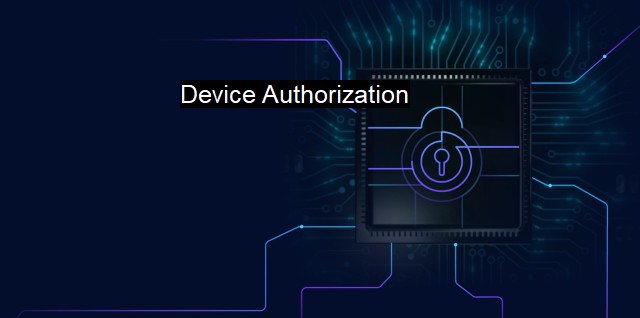What is Device Authorization?
The Significance of Device Authorization for Cybersecurity and Data Protection
Device Authorization is a cybersecurity process that allows or restricts access to a certain device based on a prescribed set of policies or identifiers. It's a crucial element in any security strategy, as it helps protect sensitive data from unauthorized access and prevent potential security threats.In this digital era where numerous devices are frequently connected to networks, a robust device authorization framework is critical. It helps in maintaining system integrity, preventing breaches, and safeguarding valuable data. It ensures that only duly accredited devices are permitted access, thereby minimizing the risk associated with unauthorized or compromised equipment.
Most events of data breach or insecurity source from unauthorized device access. In simple terms, unauthorized access is when a device is used to gain unlawful entry into a system, site, or resource without the user's consent. This is why device authorization is critical; it forms the first line of resistance towards these unauthorized accesses. If a device isn't authorized, it can't infiltrate the system to bring harm to the data and systems.
Understanding the importance of device authorization, many cybersecurity firms are providing comprehensive solutions that include tools uniting endpoint and network security. An array of mechanisms has been developed to regulate and enforce device authorization effectively. Primary among these are Access Control Lists (ACLs), MAC (Mandatory Access Control), and RBAC (Role-Based Access Control), to name a few.
ACLs provide an orderly way of regulating access rights for the different devices. Using these lists, the system checks whether a device trying to gain access is enrolled, verifying its credibility to grant or deny access . MAC, on the other hand, works based on predefined policies that control the interactions between devices. RBAC associates permissions with roles (admin, user, etc.) rather than attaching them to individual identifiers.
An essential component within device authorization is the use of antivirus solutions. Antivirus software is a program developed to prevent, search for, detect, and remove software viruses and other malicious software like worms, Trojans, and adware. This forms another layer of security; even though a device may be authorized, this doesn't rule out the possibility of it hosting malicious programs. Installing reputable antivirus software helps counteract such potential issues by regular scanning and immediate threat neutralization.
Device authorization also extends to online services where a user's device first has to be confirmed and authorized before it can explore the service in its entirety. It's usually managed through multifactor authentication where the user is required to provide two or more verification forms pulled from different categories of credentials.
Key to this discussion is device sacrifices – situations where devices deemed insecure are banned from accessing the concerned resources. Apart from any physical signs of interference, recurrent system login failures or repetitive attempts to breach the system raise a flag, and such a device gets deregistered until full compliance is achieved.
As the tech world evolves, so does the sophistication of cyber threats. Therefore, organizations need to continually review and upgrade their device authorization policies and practices. This, combined with antivirus solutions, forms an investment that any organization or system owner can't afford to disregard. device authorization is the game changer in today's digital security. It presents a proactive approach of handling cyber threats, keeping them at bay before they happen.

Device Authorization FAQs
What is device authorization in cybersecurity?
Device authorization is the process of granting access to a specific device to perform certain actions or access certain information. This is a common practice in cybersecurity to ensure that only authorized devices are allowed to access sensitive information or perform certain tasks.Why is device authorization important for antivirus software?
Device authorization is important for antivirus software as it helps to ensure that only trusted devices are able to access the antivirus program and its sensitive data. Without device authorization, malicious actors could potentially gain access to the antivirus software and disable it, leaving the device vulnerable to attacks.How does device authorization work?
Device authorization typically involves a process where the user or administrator grants access to a specific device by adding it to a list of authorized devices. This can be done through various methods such as inputting a device's unique identifier or IP address, or confirming physical access to the device. Once authorized, the device is granted access to perform specific actions or access certain information.What are the benefits of device authorization in cybersecurity?
Device authorization has several benefits in cybersecurity, including increased security, improved control over device access, and better tracking of device activity. By only allowing authorized devices to access sensitive information or perform certain actions, the risk of data breaches or malicious attacks is significantly reduced. In addition, device authorization allows administrators to have better control over who can access certain information or perform certain tasks, and to track the activity of authorized devices to ensure they are being used appropriately.| | A | | | B | | | C | | | D | | | E | | | F | | | G | | | H | | | I | | | J | | | K | | | L | | | M | |
| | N | | | O | | | P | | | Q | | | R | | | S | | | T | | | U | | | V | | | W | | | X | | | Y | | | Z | |
| | 1 | | | 2 | | | 3 | | | 4 | | | 7 | | | 8 | | |||||||